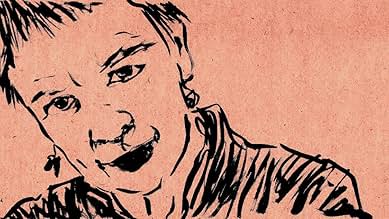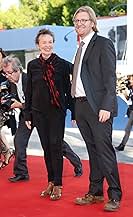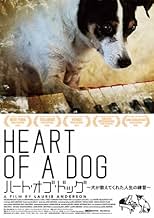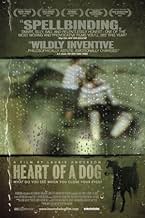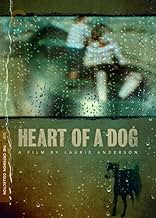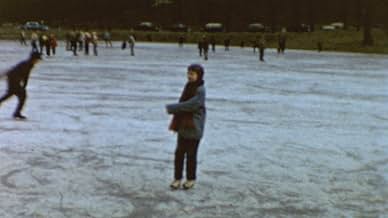IMDb-BEWERTUNG
7,0/10
2607
IHRE BEWERTUNG
Die Musikerin, Künstlerin und Regisseurin Laurie Anderson reflektiert über ihre Beziehung zu ihrem geliebten Terrier Lolabelle.Die Musikerin, Künstlerin und Regisseurin Laurie Anderson reflektiert über ihre Beziehung zu ihrem geliebten Terrier Lolabelle.Die Musikerin, Künstlerin und Regisseurin Laurie Anderson reflektiert über ihre Beziehung zu ihrem geliebten Terrier Lolabelle.
- Auszeichnungen
- 4 Gewinne & 13 Nominierungen insgesamt
Laurie Anderson
- Self - Narrator
- (Synchronisation)
Dustin Guy Defa
- Gordon Matta-Clark
- (as Dustin Defa)
Jess Irish
- Nurse
- (as Jessica Irish)
Handlung
WUSSTEST DU SCHON:
- WissenswertesAccording to Laurie Anderson, the film was shot on her iPhone and other small digital devices.
- Zitate
[from trailer]
Herself, narrator: I wanna tell you a story about a story, and it's about the time I discovered that most adults have no idea what they're talking about.
- VerbindungenFeatured in Women Make Film: A New Road Movie Through Cinema (2018)
- SoundtracksThe Lake
from "Homeland"
Written and Performed by Laurie Anderson
Produced by Laurie Anderson (uncredited), Roma Baran (uncredited) and Lou Reed (uncredited)
Courtesy of Nonesuch Records
Ausgewählte Rezension
In her poetic film collage essay, Laurie Anderson is more beautifully and thoughtfully herself than ever. She has had a long career, but was most well-known in the 80's as an experimental performance artist, composer, and musician who especially explored the mix of spoken word and music. Those who know her albums such as "Big Science" and "Home of the Brave" will appreciate the return of the fragmented rhythm and quizzical tone of Anderson's speech, opening with voice-over sentences such as "This is my dream body – the one I use to walk around in my dreams."
Despite the film's seemingly stream-of-conscious, no-plot, hodge- podge approach, Anderson has meaningful ideas to express, and she's woven together an elegant and smartly structured tone-and-picture poem. The movie combines her personal stories and musings with quotations from renowned philosophers, ink drawings on paper, printed words, animation, scratchy old 8mm home-movie clips, new footage of landscapes, surveillance camera footage with time codes, graphic images such as computer icons, and her ingenious use of music. As always, Anderson excels at language, and here she combines various types of on-screen text with her own lyrical voice-over. I often leave a movie wanting to run home and download the soundtrack, but in this case I am yearning for a transcript. These are words worthy of reading and contemplating. "Try to learn how to feel sad without being sad," is just one of the many sentences that could use more time to resonate than one viewing allows.
But one of the surprises of this project may be Anderson's sophisticated and inventive cinematography. As the film explores a variety of deaths – the death of Anderson's dog, the death of her mother, the death of her husband (Lou Reed), and the mass deaths of 9/11 in New York, it seems the movie is often shedding its own tears. Many sequences are shot through a pane of glass that is dripping with water, like life itself is crying. And then she turns footage of an ocean upside down, with the foreground still raining, so the sea that has become the sky is weeping too. In front of everything, Anderson seems to be saying, is a gentle, pervasive sadness.
And yet, the movie is not even remotely maudlin. It discusses 9/11 in way that actually adds fresh insight, which seems impossible after so many anniversaries full of remembrance ceremonies, and so many other films that have also integrated that tragic event.
Perhaps the strongest moment in Anderson's film is when she takes her dog outdoors in a big field and enjoys watching her run and play in tall grass and aromatic dirt, as dogs do. And the camera pans up to the bright blue sky; it is such a beautiful day. And then we see pretty white trails in the sky, moving in circles. Anderson tells us they are birds. And then she sees that they are hawks. And she describes the look in the eyes of her dog, Lolabelle, as the dog peers up and realizes that she is prey. The dog understands that these birds have come for the purpose of killing her. And Anderson bemoans the new reality that now the dog must not only be aware of the ground and the grass and the other earthbound creatures, but also that huge, untouchable expanse of sky. The sky is now a danger. And the dog will never view the sky the same again. Cut to footage of 9/11 as Anderson compares her dog's feeling to hers, and ours, when we suddenly understood that "something was wrong with the air"; the sky brought danger and those flying planes were there for the purpose of killing us. And "it would be that way from now on."
Anderson goes on to talk about the strangeness of living in a post- 9/11 surveillance state, where we are always being recorded. But she does not take the obvious path of complaining about the social injustice. Instead, she takes a clever twist and points out that all your actions are now data. And that data is always being collected, but it will not be watched until after you commit a crime. Then your story is pieced together, in reverse – footage of where you went and what you did, being viewed backwards from the most recent moment. And then she throws in a quote from Kierkegaard: "Life can only be understood backward but must be lived forward."
And intermixed with philosophy, Anderson keeps her wry sense of humor. At one point, she talks about a dream in which she gives birth to her dog. She illustrates the tale with bizarre comic drawings, and then she tells us that the dog looks up at her and says, "Thank you so much for having me," as if it has just been invited to a tea party. Ha. Later she talks about her own childhood memory of a trauma and reveals how our minds naturally clean up memories, leaving out certain details, and in that way you are holding onto a story and every time you tell the story, you forget it more. Cut to the computer icon of Missing File. The associations keep piling up, and they do indeed add up. It uses a complex and intellectual style, very astutely, to access emotional and intimate realities that are difficult to reach through overt methods. This film does tell a story, in its own subtly layered way.
It is sometimes a meditation on how to go on living despite despair – "the purpose of death is the release of love," but it is also clearly Laurie Anderson's own personal tale. This is a tender memoir. It's Anderson's love story, about her dog, her mother, her husband, and her city. In the most uncommon and evocative way, this film has heart.
Despite the film's seemingly stream-of-conscious, no-plot, hodge- podge approach, Anderson has meaningful ideas to express, and she's woven together an elegant and smartly structured tone-and-picture poem. The movie combines her personal stories and musings with quotations from renowned philosophers, ink drawings on paper, printed words, animation, scratchy old 8mm home-movie clips, new footage of landscapes, surveillance camera footage with time codes, graphic images such as computer icons, and her ingenious use of music. As always, Anderson excels at language, and here she combines various types of on-screen text with her own lyrical voice-over. I often leave a movie wanting to run home and download the soundtrack, but in this case I am yearning for a transcript. These are words worthy of reading and contemplating. "Try to learn how to feel sad without being sad," is just one of the many sentences that could use more time to resonate than one viewing allows.
But one of the surprises of this project may be Anderson's sophisticated and inventive cinematography. As the film explores a variety of deaths – the death of Anderson's dog, the death of her mother, the death of her husband (Lou Reed), and the mass deaths of 9/11 in New York, it seems the movie is often shedding its own tears. Many sequences are shot through a pane of glass that is dripping with water, like life itself is crying. And then she turns footage of an ocean upside down, with the foreground still raining, so the sea that has become the sky is weeping too. In front of everything, Anderson seems to be saying, is a gentle, pervasive sadness.
And yet, the movie is not even remotely maudlin. It discusses 9/11 in way that actually adds fresh insight, which seems impossible after so many anniversaries full of remembrance ceremonies, and so many other films that have also integrated that tragic event.
Perhaps the strongest moment in Anderson's film is when she takes her dog outdoors in a big field and enjoys watching her run and play in tall grass and aromatic dirt, as dogs do. And the camera pans up to the bright blue sky; it is such a beautiful day. And then we see pretty white trails in the sky, moving in circles. Anderson tells us they are birds. And then she sees that they are hawks. And she describes the look in the eyes of her dog, Lolabelle, as the dog peers up and realizes that she is prey. The dog understands that these birds have come for the purpose of killing her. And Anderson bemoans the new reality that now the dog must not only be aware of the ground and the grass and the other earthbound creatures, but also that huge, untouchable expanse of sky. The sky is now a danger. And the dog will never view the sky the same again. Cut to footage of 9/11 as Anderson compares her dog's feeling to hers, and ours, when we suddenly understood that "something was wrong with the air"; the sky brought danger and those flying planes were there for the purpose of killing us. And "it would be that way from now on."
Anderson goes on to talk about the strangeness of living in a post- 9/11 surveillance state, where we are always being recorded. But she does not take the obvious path of complaining about the social injustice. Instead, she takes a clever twist and points out that all your actions are now data. And that data is always being collected, but it will not be watched until after you commit a crime. Then your story is pieced together, in reverse – footage of where you went and what you did, being viewed backwards from the most recent moment. And then she throws in a quote from Kierkegaard: "Life can only be understood backward but must be lived forward."
And intermixed with philosophy, Anderson keeps her wry sense of humor. At one point, she talks about a dream in which she gives birth to her dog. She illustrates the tale with bizarre comic drawings, and then she tells us that the dog looks up at her and says, "Thank you so much for having me," as if it has just been invited to a tea party. Ha. Later she talks about her own childhood memory of a trauma and reveals how our minds naturally clean up memories, leaving out certain details, and in that way you are holding onto a story and every time you tell the story, you forget it more. Cut to the computer icon of Missing File. The associations keep piling up, and they do indeed add up. It uses a complex and intellectual style, very astutely, to access emotional and intimate realities that are difficult to reach through overt methods. This film does tell a story, in its own subtly layered way.
It is sometimes a meditation on how to go on living despite despair – "the purpose of death is the release of love," but it is also clearly Laurie Anderson's own personal tale. This is a tender memoir. It's Anderson's love story, about her dog, her mother, her husband, and her city. In the most uncommon and evocative way, this film has heart.
- helen-51122
- 20. Dez. 2015
- Permalink
Top-Auswahl
Melde dich zum Bewerten an und greife auf die Watchlist für personalisierte Empfehlungen zu.
- How long is Heart of a Dog?Powered by Alexa
Details
- Erscheinungsdatum
- Herkunftsländer
- Offizielle Standorte
- Sprache
- Auch bekannt als
- Corazón de perro
- Drehorte
- Produktionsfirmen
- Weitere beteiligte Unternehmen bei IMDbPro anzeigen
Box Office
- Bruttoertrag in den USA und Kanada
- 420.813 $
- Eröffnungswochenende in den USA und in Kanada
- 13.893 $
- 25. Okt. 2015
- Weltweiter Bruttoertrag
- 495.865 $
- Laufzeit1 Stunde 15 Minuten
- Farbe
- Seitenverhältnis
- 1.78 : 1
Zu dieser Seite beitragen
Bearbeitung vorschlagen oder fehlenden Inhalt hinzufügen




